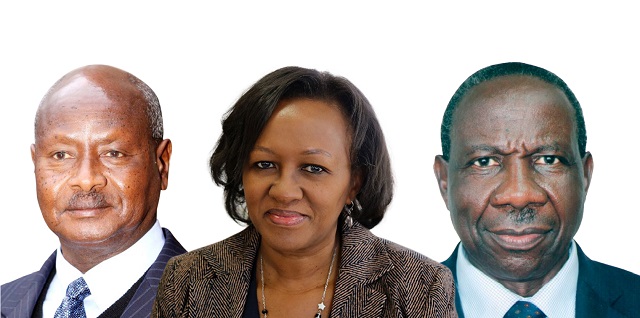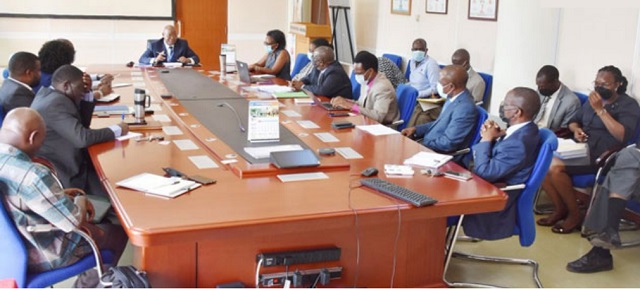
Museveni’s dream and numbers that don’t lie
Kampala, Uganda | RONALD MUSOKE | Since President Yoweri Museveni announced on June 7, rather surprisingly, that Uganda had attained Lower Middle Income status, the question has been why the President appears desperate for Uganda to attain that rank.
Several views have been expressed but the leading ones appear to be two; that the President is looking for political capital and that he is looking for leverage with international lenders.
Godber Tumushabe, a policy analyst and Associate Director of the Great Lakes Institute for Strategic Studies (GLISS), a Kampala-based policy think tank told The Independent on July 8 that leaders of underdeveloped countries like Uganda with governments that have got little to offer to their citizens, “being categorized as ‘middle income’ gives the governments a bit of political mileage.”
He said, however, getting into this category also comes with benefits especially when it comes to accessing international credit.
“It means you can borrow more because the international lending institutions have more confidence in your economy,” he said.
Museveni’s announcement of Uganda’s ‘Middle Income status’ was during his State of the Nation address to parliament. He framed achieving Middle Income status as fulfillment of Point No. 5 of the NRM 10 point programme: “to build an independent, self-sustaining national economy.”
The President said Uganda’s GDP per capita now stands at US$, 1046.
“You remember the entrance point for the Lower Middle-Income status is US$1,036. We have now passed that figure,” Museveni said. Based on his facial expression, he possibly expected his audience to cheer. But no cheers followed.
“Congratulations,” the President said. But it was to scattered clapping. It appears Museveni’s announcement stunned the nation, including staff at the Ministry of Finance.
In fact, Museveni again appeared disappointed that the Minister of Finance, Matia Kasaija, did not mention it in his presentation of the Financial Year 2022/23 budget, a week later on June 14.
“The minister did not come out to say that we are at the entrance of the middle income status. I don’t know whether he feared that we shall go back. I don’t think we shall,” Museveni said in remarks after Kasaija’s speech.
But the proof that Museveni’s Middle Income status announcement was a sign of trouble in his Ministry of Finance came two weeks later on June 30 and from none other than the World Bank Country Director, Rosemary Mukami Kariuki.
Kariuki presented to the media the “Uganda Economic Update 19th Edition” which reported that, according to the World Bank, the Uganda economy has been growing too slowly while its population was growing too fast, leaving the country unable to attain Middle Income Status.
According to the update, Uganda would have attained lower middle income status already if strong growth rates of between 6-10% posted between 2001 and 2011 had been maintained.
At the time, the gap to lower middle income reduced to just 17% from 76% recorded in 1994, but since 2011, it has been between 19% and 26% as economic growth slowed down while population growth rates remained high.
“With the lower growth than the pre-pandemic projections, the gap between the actual per capita income and the NDPIII target has widened and the time for Uganda to reach the lower middle income target elongated,” says the report.
“Overall growth for FY22 is estimated at 3.7% below the pre-COVID-19 projections of over 6%, leaving Uganda’s per capita income estimated at about US$ 840, well below the lower middle income threshold of US$1,045 per person,” the report reads in part.
The World Bank went ahead to say it doubts Uganda will attain the middle income status in the near future unless the economy grows a little faster than the current rate.

UBOS disputes figures
The World Bank declaration appears to have sparked a numbers dispute with the Uganda Bureau of Statistics (UBOS). A meeting of teams from the two institutions and others to synchronize their figures on July 04 also appears to have ended without the anticipated joint statement.
At the centre of their disagreement is which set of data should be used to determine whether Uganda has attained Lower Middle Income status or not.
On July 06, UBOS called a press conference in which Chris Mukiza; its executive director told journalists that the Ugandan economy is within the threshold of the lower middle income status based on their statistical data computations. He said the World Bank is mixing up their figures and using wrong parameters to downgrade the Uganda economy.
“Uganda’s official Gross Domestic Product (GDP) per capita is US$ 1, 046,” Mukiza said citing the same figure as was stated by President Museveni during his State of the Nation address on June 7.
UBOS said the World Bank used data for the financial year 2020/2021 to compile its report yet President Museveni considered figures from 2021/22 the most update.
UBOS added that the World Bank also applied the UN population projections for Uganda which are not official, resulting in a wrong report.
“The UN mid-year population for Uganda, for the financial year 2020/21 is 47.1 million,” UBOS said, “However, the government of Uganda’s official population projection for the same period is 42.4 million, resulting in a 4.7 million difference,” Mukiza said.
The population and GDP figures are important because, to determine the income per capita or per person in an economy, economists sum up the total amount of money earned by citizens and businesses in a year. This is then divided by the population total to get the Gross National Income (GNI).
To use a common Ugandan imagery, GNI measures that monetary value of the national cake for the year. When the national cake is divided by the population, it gives every person’s average share of the cake or the “income per capita.” If the cake is shared equally by more people, each one will mathematically get a smaller share.
And if that share determines whether a country has attained Middle Income status or not, then the population size becomes an issue. That is why population size appears to be at the heart of the cross-talking between the World Bank on one side and President Museveni and UBOS on the other.
Is the Uganda population 47.1 million people as per World Bank or 42.4 million people as per UBOS and Museveni? That appears to be the major question. According to UBOS, even if one uses figures of Uganda’s population for mid-2022, that would be only 43.7 million people.
There are other minor tiffs. President Museveni and UBOS prefer to use the Gross Domestic Product (GDP) as the measure of national wealth. UBOS says that stands at US$43.23 billion. According to economists, however, if computed properly, the difference between GDP and GNI is minimal. And based on the agreed World Bank for Lower Middle Income status at US$1,036, it appears President Museveni and UBOS appear to be winging it to squeeze through.
In his address of June 07, for example, President Museveni used qualifiers to push his point. First, he pushed the numbers by saying “by the budget time,” then a week away on June 14, the Uganda economy would be standing at US$ 45.7 billion. But that is by “the exchange rate method” and “at USD 131.6 billion by the PPP method.” That is how he managed to get the GDP per capita now of US$1046.
If Museveni had used the UBOS figure of the GDP at US$43.23 billion and a population size of 42.4 million people, to calculate, Uganda’s GDP per capita would have been US$1019.5 and only US$917 if he had used the World Bank population estimate for Uganda of 47.1 million people.

How to enter Middle Income loop
According to the World Bank, lower middle income countries are those with a Gross National Income (GNI) per capita which is between US$1,036 and US$ 4,045 while upper middle income countries are those with a GNI per capita which is between US$ 4,046 and US$ 12,535.
The World Bank calculates Gross National Income after adding the incomes of citizens of the country at home and abroad. It differs when calculating the GDP of a country which in this case includes all economic activities for all nationals and foreign residents but excludes the earnings of a country’s citizens living abroad.
Based on these calculations, Nigeria which is Africa’s largest economy with a GDP of over US$520 billion is a lower middle income country; largely because of its large population.
It appears squeezing into the Middle Income category does not mean people’s everyday problems dissipate over night. In fact Uganda could have far better socio-economic indicators than countries like South Sudan which are technically lower middle income.
In 2019, for instance, the United Nations Development Programme (UNDP) ranked Equatorial Guinea, an upper middle income country, 144th out of 189 countries in its Human Development Report which combines life expectancy, education and per capita income data. According to the UN, more than half of Equatorial Guinea’s 1.4 million people still lack access to clean water.
In Uganda’s case, it remains unclear how the impasse between the World Bank and the government will be resolved.
Godber Tumushabe, a former advisor to the Ministry of Finance, told The Independent on July 8 that it is difficult to know who exactly is telling the truth considering the fact that both institutions (UBOS and the World Bank) have worked together for a long time on the country’s economic data.
“If they are having disagreements at the moment, this can only imply that there is perhaps a breakdown in their relationship or that one of them is being dishonest with their data.
Bernard Sabiiti, a policy analyst based at Development Initiatives, a global organisation that has expertise to work with data to build sustainable solutions that create an equitable and resilient world told The Independent on July 8 that it is the methodology that seems to be at the heart of the misunderstanding between UBOS and the World Bank, and not any intentional effort to fudge the numbers, on either UBOS’ or the World Bank’s part.
“I understand the frustration of UBOS because it is certainly one of the better performing MDAs in the country,” he said, “UBOS is ranked among the best national statistics agencies in Africa and they have historically produced top notch peer reviewed data that all our development partners rely on to make key investment decisions.”
But Sabiiti quickly adds the World Bank also cares about the methodology because wrong numbers could have serious implications at the international level where, for instance, big decisions on extending credit facilities to developing countries depends on such metrics.
“If you misinterpret the numbers, it can have serious implications. It is not possible to lie about the development indicators because there are so many other ways of determining a country’s economic development pathway.”
Doubts about Museveni numbers
Doubts about President Museveni’s proclamation of June 07 were not helped by his painting a glorious image of the economy at a time when millions of Ugandans are struggling with high commodity prices. Many asked what exactly had happened between January and June that made the economy suddenly expand.
“Whether Uganda has attained lower middle income status or not is irrelevant at the moment considering the economic hardship being experienced by ordinary Ugandans,” Tumushabe told The Independent.
Sabiiti explained that due to the current inflation, many Ugandans rightly feel they are much worse off as they are struggling to put food on the table.
“Prices of basic/essential goods and services are through the roof. This could have also reduced the purchasing power of the middle income amount reported.”
“Still, that does not mean that UBOS is wrong. It would still be right despite the people not feeling that middle income vibe.”
“It simply means the GDP per capita method which is the gold standard used around the world to measure these things is faulty and that one needs to look at other socio-economic factors to truly understand the state of a country’s development progress.”
The socio-economic factors include population growth, which in Uganda’s case according to the World Bank grew at a high rate, leaving the per capita income stagnant. The World Bank says for as long as the majority of Ugandans are outside the money economy, even if the GDP is growing, it should grow fast enough to cater to the ever bludgeoning population, especially in terms of public service delivery.
Mukami Kariuki also says it is crucial for the government to adopt targeted interventions to support the vulnerable while managing debt and rising inflation.
She said oil and gas which the government hopes will finally get pumped out of the Albertine graben in 2025 can help the economy grow, but that this will only happen when the government diversifies the economy, especially by not losing focus on the agriculture sector.
“Policy makers face new uncertainties and challenges that must be managed cautiously, given the tradeoffs, between rising inflation and supporting the recovery.
Why it matters to Museveni
This is not the first time that President Museveni has talked about Uganda joining or getting close to joining lower middle income category.
During a luncheon organised for his outgoing Cabinet on May 4, 2016, President Museveni commended them for “almost” taking Uganda to middle income status. Sounding optimistic, Museveni said his next term (2016-2021) would be much easier thanks to an expected windfall of oil export dollars.
“By 2019, we shall be getting our oil money. Things that we did by borrowing like infrastructure will be done more easily with our own money,” he said.
“We have finished the issue of the pipeline and (we) are going to start exporting our oil.” Museveni told his outgoing Cabinet that Uganda’s GDP would grow at 6.14% and per capita income would rise to US$1,039 by 2019 and this would essentially make Uganda leap into the lower middle income bracket.
But even then, Antoinette Sayeh, the then IMF Director for Africa had cautioned Uganda against pinning its middle income dream on anticipated oil money. She said since oil prices have the tendency to be volatile, it was important to tread with caution. Uganda missed its 2020 first oil target and that perhaps contributed to its miss.
Fred Muhumuza, a development economist labelled the government ambition at the time as a “political joke” because he doubted Uganda would even tap “first” oil by 2019.
Muhumuza told The Independent then that for Uganda to reach middle income, the government would need to generate a GDP of US$43.89bn, an increase of 78% over the next five years. That would have to contend with a population growth rate that adds at least 1.15 million every year.
More recently, while speaking at this year’s Liberation Day celebrations on Jan.26 at Kololo Independence Ground in Kampala, President Museveni said Uganda would attain lower middle income status by 2026. The President was explaining why the original target of 2020 had been missed. He said Uganda’s economy or GDP would be worth about US$44 billion this month of July.
“This means that the economy has grown 29 times since 1986 when it was just US$ 1.5 billion. And in July (2022), the GDP per Capita will be about US$980. That is very near to the Middle Income status which is US$1039,” Museveni said.
Museveni then attempted to explain why the country had failed to get into the lower middle income country as expected five years earlier. He said the country would have actually achieved middle income status if it had not been for the COVID-19 pandemic which devastated Uganda’s economy in 2020.
Going forward Bernard Sabiiti told The Independent that next year’s national census will provide more clarity on whether Uganda has attained lower middle income status or not.
Sabiiti explained to The Independent that since the last census was done in 2014 statisticians keep using estimates because they know both Uganda’s population growth rate and the fertility rate so they can predict with precision the number of babies being produced in the country every year.
“But all this will be clear after the next census is conducted next year. With the latest population figures, there will be no more ambiguity and we will know whether Uganda is a lower middle income country or not.”
In the meantime, Sabiiti says the current disagreement between UBOS and the World Bank has proved two things; that statistics don’t lie but also, that it is after all not true that politicians don’t care about numbers.
“Uganda entering lower middle income status would certainly be a positive for the NRM government which explains Museveni’s obsession with the status.”
****
 The Independent Uganda: You get the Truth we Pay the Price
The Independent Uganda: You get the Truth we Pay the Price



Dear independent.co.ug Administrator, similar right here: Link Text